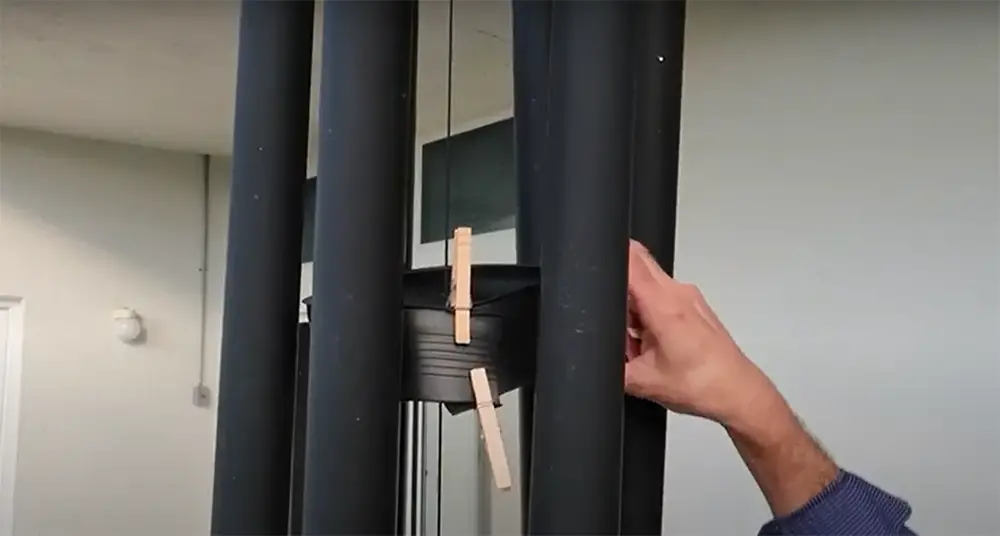Wind chimes are a beautiful addition to any outdoor space. They provide a pleasant sound and can be very therapeutic for those who live in close proximity. However, if you’re trying to sleep at night, wind chimes can become an annoyance.
This article discusses how to silence wind chimes at night so that your home is more peaceful and enjoyable during the evening hours!
Table of Contents
What Makes Wind Chimes Noisy?

The size, weight, and length of the tubes or rods will affect the pitch of the sound that is created. The width and depth of the tube also affect the tone quality. The material that is used to make the chimes will also have an impact on the sound that is produced.
The wind chimes that are commonly found in the United States are usually made of metal, glass, or bamboo. The metal tubes produce a higher-pitched sound and the glass tubes create a lower-pitched sound. Bamboo chimes tend to have a more mellow tone quality than the other materials.
Wind chimes can be quite noisy if they are not properly tuned. They can also be disruptive if they are located near bedroom windows or patios. It is possible to silence wind chimes by using some common household items.
Wind chimes can be very soothing to listen to during the day but they might not be so pleasant at nighttime if you need silence for sleep or relaxation purposes.
Wind chimes are popular household decorations that many people enjoy having. If you have wind chimes outside near your bedroom window, it might be a good idea to look into some ways of muffling the sounds they make at nighttime. There are several possible solutions for this problem and most can easily fit inside any budget!
Popular Methods to Silence Wind Chimes:
1) Use a big cotton ball

Blocking off and muffling sound is a very easy fix for this problem. Simply take a cotton ball and wrap it around the tube where you want to control the noise or sounds that are produced. This is an easy and affordable way to fix the issue.
This will stop any rattling, clanging, or banging of the rod against another one when there’s no breeze blowing outside.
This method works best if you have several rods on your wind chimes as opposed to just one long string with many bells attached at different intervals along its length.
You could also try hanging some heavy drapes in front of the window where your wind chime is located if that’s an option for you! This might be the best solution if you live in an apartment and don’t want to disturb anyone else with the noise coming from your chimes at night.
One option is to use a large metal washtub or bucket. The tub needs to be at least twice as wide as the diameter of your tubes or rods.
Another option is to use an empty paint can with both ends removed. Make sure that whatever container you choose has a smooth bottom so it won’t create any additional noise when placed on top of the tubes or rods.
2) Softening metal wind chimes

Be sure to test out the sound of your wind chimes after applying any type of sealant or coating so that you can decide if it’s made a noticeable difference or not.
Another option would be to wrap the tubes in some type of padding such as an old towel, tee-shirt, socks, etc. This will also help to muffle the sounds somewhat and might be a good solution if you don’t want to apply any type of chemical to your wind chimes.
If you try these methods and notice that the sounds are still too loud, consider hanging your wind chime somewhere else like in a tree outside or near the corner of your house away from where people sleep inside. You could also think about replacing metal rods with plastic ones as they will make much less noise when there’s no breeze blowing at all!
Tips to Silence Wind Chimes:
- Try using a big cotton ball to block and muffle the sound. This is an easy and affordable way to fix the issue;

- You can also wrap tubes in some type of padding such as an old towel, tee-shirt, socks – this will also help muffle the sounds somewhat;
- Try hanging your wind chime somewhere else like in a tree outside or near the corner of your house away from where people sleep inside;
- Coating metal wind chimes with a sealant or softener can help reduce noise levels;
- Hang your wind chime somewhere else like in a tree outside or near the corner of your house away from where people sleep inside;
- Replace metal rods with plastic ones for less noise when there’s no breeze blowing at all;
Comparing Techniques to Silence Wind Chimes at Night
Wind chimes can create a beautiful melody during the day, but their sounds can become a nuisance at night. Fortunately, there are various techniques to silence wind chimes, each with their own advantages and disadvantages. In this table, we will compare the effectiveness, ease of implementation, and cost of some of the most popular techniques.
| Technique | Effectiveness | Ease of Implementation | Cost |
|---|---|---|---|
| Removing the Wind Sail | High | Easy | Free |
| Shortening the Length of the Chimes | Medium | Moderate | Low |
| Wrapping the Chimes with Tape | Low | Easy | Low |
| Applying WD-40 to the Chimes | Medium | Easy | Low |
| Bringing the Wind Chimes Indoors | High | Difficult | High |
The table above compares five techniques to silence wind chimes at night, based on their effectiveness, ease of implementation, and cost. Removing the wind sail is the most effective and easiest technique, and it’s free. Shortening the length of the chimes is moderately effective, somewhat difficult to implement, and relatively inexpensive. Wrapping the chimes with tape is easy to implement but not very effective, and it’s relatively inexpensive. Applying WD-40 to the chimes is moderately effective and easy to implement, but it requires the purchase of a lubricant. Bringing the wind chimes indoors is the most effective but also the most difficult technique, and it’s expensive if you don’t have a suitable indoor space already. Overall, the table provides a quick overview of the pros and cons of each technique, allowing readers to choose the one that best fits their needs.
FAQ
How can I make my wind chimes quieter?
A few things you can do to make your wind chimes quieter:
- Use smaller or lighter chimes;
- Hang the chimes in a more sheltered spot;
- Wrap the clapper (or striker) in fabric or tape;
- Place something between the chime and the clapper (e.g., a small piece of wood);
If these tips don’t work, try wrapping the entire chime in fabric or moving it to a less windy spot. You may also want to consider purchasing a set of wind chimes that are designed to be quiet.
Do neighbors find wind chimes annoying?
This is a common question asked by people living in apartments, condos, or even single-family homes. There are many options to consider when solving this problem like turning the wind chimes off at night (easy), adding weights (medium), and hanging them away from your home (hard):
- For one thing, you can simply turn the wind chimes off at night. This sounds simple but it may not be practical depending on where they are hung e.g. if there’s no switch nearby then using an extension cord will need power so do check for safety concerns first before trying this option out;
- Another option would be to add some weight to the bottom of each tube so that less air gets through which would mean less noise produced overall especially during strong gusts of wind;
- Lastly, you could try to hang the chimes in a location further away from your home such that the noise they create will be less likely to travel indoors. This is often not a popular option because it can require more work and also may be aesthetically unpleasing to some people;
When should you take wind chimes down?
However, if you’ve tried all of these options and still find the noise produced by wind chimes a nuisance then it might be time to take them down:
- Moving into another room or even inside your garage for some peace and quiet will help too during those noisy times;
- If neighbors are complaining about the sound they’re producing (and especially if there’s no way around this problem) then taking them down may be necessary;
- You might also use earplugs but bear in mind that you will not hear any distinctive noises such as birds singing or children playing outside, both of which can decrease safety awareness and the overall quality of life. This is why many individuals prefer to turn off their wind chimes before going to bed;
- Also, consider whether living in an apartment building might be better for you. It’s often not as expensive and can provide more freedom too;
Are wind chimes considered noise pollution?
When it comes to wind chimes, many people are divided on whether they’re noise pollution or not:
- Some say that the sound generated by them is simply a pleasant one instead of an irritating or even deafening sound;
- Others find that these can be distracting especially during quiet times like at night when you’d want to sleep but couldn’t because of all the clanging noises outside your window e.g. if neighbors have them hanging in their backyards then this could affect how well you get rest every night too;
- Yet others point out that there’s no conclusive evidence yet so more research needs to be done before making any conclusions for sure about which side is right and which isn’t;
Why do people put up wind chimes?
For some homeowners, it’s because they think that this will improve their home’s curb appeal i.e make it more attractive to visitors e.g. if you have a front yard then adding them there may be one of your options.
Others are convinced that these can help out with Feng Shui which is basically an ancient Chinese practice where objects are placed inside buildings or homes for particular reasons like making sure energies flow smoothly through all parts of the property (but remember though that not everyone agrees on how effective this practice really is).
Finally, others simply enjoy listening to them especially during autumn or wintertime when the air tends to grow cooler and crispier. This is because the sound of wind chimes can be quite relaxing and even therapeutic for some people.
How do you adjust wind chimes?
If you want to adjust wind chimes so that they can produce more pleasant noises, try doing the following:
- Make sure that each tube is open at both ends instead of blocked by a cork or other material. This way air will be able to go through them easier which means less resistance and thus better sounding notes overall;
- Place it in an area where there’s minimal interference from trees branches, for example, because this could cause even bigger problems with noise emissions especially during strong gusts of wind. Try hanging your wind chime away from these areas if possible;
Why are wind chimes relaxing?
Wind chimes are relaxing for several reasons:
- The sound they produce is usually soothing and isn’t exactly grating on the ears;
- They’re great at producing calming effects especially after you’ve had a long day of work or school. This can help reduce stress levels in many people which means that it’s also good for alleviating insomnia because instead of tossing and turning all night, you’ll be able to fall asleep faster due to this effect;
Some believe that this kind of hanging decorations was actually used by ancient cultures like Native Americans as well as those living in Asian countries including Japan so using them today may still allow us to connect with their past. So, if you want some history lessons then placing wind chimes near homes could be a good way to achieve this goal.
And, finally, you can’t ignore the fact that it’s also relaxing because of its aesthetically pleasing appearance which is why many people want them as part of their decor whether indoors or outdoors. This charm and beauty may even increase your property value especially if potential buyers are interested in wind chimes too!
What are wind chime strings made of?
Wind chime strings can be made from a variety of materials, including nylon, metal, hemp, and cotton. The type of material used can affect the sound quality and durability of the wind chime.
What is the ideal length for wind chime strings?
The ideal length for wind chime strings depends on the desired pitch and sound of the chimes. As a general rule, longer strings produce lower pitches, while shorter strings produce higher pitches. However, the length of the strings should be consistent for each chime in order to create a harmonious sound.
How do you tune wind chime strings?
To tune wind chime strings, you can use a pitch pipe or a piano to match the desired note. Adjust the length of the string by tying knots or cutting it until the desired pitch is achieved. It is important to tune each string in relation to the others to ensure that the wind chime produces a harmonious sound.
What is the difference between single and double wind chime strings?
A wind chime with single strings has each chime tube attached to its own string, while a wind chime with double strings has two tubes attached to a single string. Double strings are often used for larger chimes to provide additional support and stability, while single strings are typically used for smaller chimes.
How do you replace wind chime strings?
To replace wind chime strings, first remove the old strings and chimes. Cut new strings to the desired length and tie a knot at one end. Thread the string through the top of the chime tube and tie another knot to secure it in place. Repeat for each chime tube, making sure that the lengths of the strings are consistent for a harmonious sound.
What is the best way to hang wind chime strings?
The best way to hang wind chime strings is to attach them to a sturdy metal or wooden hanger. Make sure that the hanger is securely attached to a beam or hook and can support the weight of the wind chimes. The strings should be evenly spaced and at the same height to ensure that the wind chime produces a harmonious sound.
What is the recommended number of chimes for wind chime strings?
The recommended number of chimes for wind chime strings depends on personal preference and the desired sound. A wind chime with fewer chimes will produce a more delicate sound, while a wind chime with more chimes will produce a fuller, more complex sound. As a general rule, a wind chime should have at least four or five chimes to produce a noticeable sound.
Can wind chime strings be customized?
Yes, wind chime strings can be customized to create a unique and personal sound. You can experiment with different materials, lengths, and thicknesses of strings to achieve the desired sound. You can also add additional chimes or incorporate different types of chimes, such as bells or glass ornaments, to create a more varied sound.
How do you care for wind chime strings?
To care for wind chime strings, regularly inspect them for wear and tear, especially if they are exposed to the elements. Replace any frayed or damaged strings as soon as possible to prevent the wind chime from becoming unstable or producing a distorted sound. You can also clean the strings with a damp cloth to remove any dirt or debris.
What is the best way to store wind chime strings?
The best way to store wind chime strings is to keep them in a dry, cool place to prevent them from becoming brittle or damaged. You can wrap them in a cloth or store them in a small bag to protect them from dust and moisture. Avoid storing wind chime strings in direct sunlight or near heat sources, as this can cause the strings to deteriorate more quickly.
What is the history of wind chime strings?
Wind chimes have been used for thousands of years in cultures all over the world. The earliest wind chimes were made from bones, shells, and other natural materials, and were used for ceremonial and spiritual purposes. Over time, wind chimes evolved into more complex and decorative designs, and were used as musical instruments and garden ornaments. Today, wind chimes are a popular form of outdoor decoration and can be found in a variety of styles and materials.






Leave a Reply